Effects of the Built Environment on Travel-Related CO2 Emissions Considering Travel Purpose: A Case Study of Resettlement Neighborhoods in Nanjing
Abstract
1. Introduction
2. Theoretical Background
3. Materials and Methods
3.1. Study Area and Neighborhoods Surveyed
3.2. Variables and Data
3.2.1. Travel Behavior
3.2.2. Travel-related CO2 emissions
3.2.3. The Features of the Built Environment in Neighborhoods
3.3. Theoretical Framework and Model
4. Results and Discussion
4.1. Goodness-of-Fit for Structural Equation Models
4.2. Results for SEMs
4.2.1. Direct Effects of the Built Environment and Socioeconomic Attributes on Travel Mode
4.2.2. Direct Effects of the Built Environment and Socioeconomic Attributes on Travel-Related CO2 Emissions
4.2.3. Indirect and Total Effects of the Built Environment and Socioeconomic Attributes on Travel-Related CO2 Emissions
5. Conclusions
Author Contributions
Funding
Institutional Review Board Statement
Informed Consent Statement
Data Availability Statement
Conflicts of Interest
References
- Kinigadner, J.; Büttner, B.; Wulfhorst, G.; Vale, D. Planning for Low Carbon Mobility: Impacts of Transport Interventions and Location on Carbon-Based Accessibility. J. Transp. Geogr. 2020, 87, 102797. [Google Scholar] [CrossRef]
- Portner, H.O.; Roberts, D.C.; Adams, H.; Adler, C.; Aldunce, P.; Ali, E.; Begum, R.A.; Betts, R.; Kerr, R.B.; Biesbroek, R. Climate Change 2022: Impacts, Adaptation and Vulnerability; IPCC: Geneva, Switzerland, 2022. [Google Scholar]
- Zhu, Q.; Leibowicz, B.D. Vehicle Efficiency Improvements, Urban Form, and Energy Use Impacts. Cities 2020, 97, 102486. [Google Scholar] [CrossRef]
- Perumal, A.; Timmons, D. Contextual Density and US Automotive CO2 Emissions across the Rural–Urban Continuum. Int. Reg. Sci. Rev. 2017, 40, 590–615. [Google Scholar] [CrossRef]
- Zhang, H.; Peng, J.; Wang, R.; Zhang, J.; Yu, D. Spatial Planning Factors That Influence CO2 Emissions: A Systematic Literature Review. Urban Clim. 2021, 36, 100809. [Google Scholar] [CrossRef]
- Acheampong, R.A. Towards Incorporating Location Choice into Integrated Land Use and Transport Planning and Policy: A Multi-Scale Analysis of Residential and Job Location Choice Behaviour. Land Use Policy 2018, 78, 397–409. [Google Scholar] [CrossRef]
- Wang, S.; Liu, X.; Zhou, C.; Hu, J.; Ou, J. Examining the Impacts of Socioeconomic Factors, Urban Form, and Transportation Networks on CO2 Emissions in China’s Megacities. Appl. Energy 2017, 185, 189–200. [Google Scholar] [CrossRef]
- Juan, Y.; Chunxiao, H. The Evolution Process and Countermeasure Research of Affordable Housing in the New Period:A Case Study of Nanjing. Mod. Urban Res. 2020, 04, 114–123. [Google Scholar]
- Fan, L.; Cao, J.; Hu, M.; Yin, C. Exploring the Importance of Neighborhood Characteristics to and Their Nonlinear Effects on Life Satisfaction of Displaced Senior Farmers. Cities 2022, 124, 103605. [Google Scholar] [CrossRef]
- Zhu, P.; Zhao, S.; Jiang, Y. Residential Segregation, Built Environment and Commuting Outcomes: Experience from Contemporary China. Transp. Policy 2022, 116, 269–277. [Google Scholar] [CrossRef]
- Zhou, Y.; Ji, H.; Zhang, S.; Qian, C.; Wei, Z. Empirical Study on the Boundary Space Form of Residential Blocks Oriented toward Low-Carbon Travel. Sustainability 2019, 11, 2812. [Google Scholar] [CrossRef]
- Ma, J.; Zhou, S.; Mitchell, G.; Zhang, J. CO2 Emission from Passenger Travel in Guangzhou, China: A Small Area Simulation. Appl. Geogr. 2018, 98, 121–132. [Google Scholar] [CrossRef]
- Yang, L.; Wang, Y.; Han, S.; Liu, Y. Urban Transport Carbon Dioxide (CO2) Emissions by Commuters in Rapidly Developing Cities: The Comparative Study of Beijing and Xi’an in China. Transp. Res. Part D: Transp. Environ. 2019, 68, 65–83. [Google Scholar] [CrossRef]
- Pérez-Neira, D.; Rodríguez-Fernández, M.P.; Hidalgo-González, C. The Greenhouse Gas Mitigation Potential of University Commuting: A Case Study of the University of León (Spain). J. Transp. Geogr. 2020, 82, 102550. [Google Scholar] [CrossRef]
- Yang, W.; Zhou, S. Using Decision Tree Analysis to Identify the Determinants of Residents’ CO2 Emissions from Different Types of Trips: A Case Study of Guangzhou, China. J. Clean. Prod. 2020, 277, 124071. [Google Scholar] [CrossRef]
- Wang, B.; Shao, C.; Ji, X. Influencing Mechanism Analysis of Holiday Activity-Travel Patterns on Transportation Energy Consumption and Emissions in China. Energies 2017, 10, 897. [Google Scholar] [CrossRef]
- Ding, C.; Liu, C.; Zhang, Y.; Yang, J.; Wang, Y. Investigating the Impacts of Built Environment on Vehicle Miles Traveled and Energy Consumption: Differences between Commuting and Non-Commuting Trips. Cities 2017, 68, 25–36. [Google Scholar] [CrossRef]
- Yang, W.; Cao, X. Examining the Effects of the Neighborhood Built Environment on CO2 Emissions from Different Residential Trip Purposes: A Case Study in Guangzhou, China. Cities 2018, 81, 24–34. [Google Scholar] [CrossRef]
- Liu, Z.; Ma, J.; Chai, Y. Neighborhood-Scale Urban Form, Travel Behavior, and CO2 Emissions in Beijing: Implications for Low-Carbon Urban Planning. Urban Geogr. 2017, 38, 381–400. [Google Scholar] [CrossRef]
- Cervero, R.; Kockelman, K. Travel Demand and the 3Ds: Density, Diversity, and Design. Transp. Res. Part D Transp. Environ. 1997, 2, 199–219. [Google Scholar] [CrossRef]
- Ewing, R.; Cervero, R. Travel and the Built Environment. J. Am. Plan. Assoc. 2010, 76, 265–294. [Google Scholar] [CrossRef]
- Ton, D.; Bekhor, S.; Cats, O.; Duives, D.C.; Hoogendoorn-Lanser, S.; Hoogendoorn, S.P. The Experienced Mode Choice Set and Its Determinants: Commuting Trips in the Netherlands. Transp. Res. Part A Policy Pract. 2020, 132, 744–758. [Google Scholar] [CrossRef]
- Liu, L.; Silva, E.A.; Yang, Z. Similar Outcomes, Different Paths: Tracing the Relationship between Neighborhood-Scale Built Environment and Travel Behavior Using Activity-Based Modelling. Cities 2021, 110, 103061. [Google Scholar] [CrossRef]
- Liu, Y.; Huang, L.; Onstein, E. How Do Age Structure and Urban Form Influence Household CO2 Emissions in Road Transport? Evidence from Municipalities in Norway in 2009, 2011 and 2013. J. Clean. Prod. 2020, 265, 121771. [Google Scholar] [CrossRef]
- Gim, T.H.T. Analyzing the City-Level Effects of Land Use on Travel Time and CO2 Emissions: A Global Mediation Study of Travel Time. Int. J. Sustain. Transp. 2021, 16, 496–513. [Google Scholar] [CrossRef]
- Hong, J. Non-Linear Influences of the Built Environment on Transportation Emissions: Focusing on Densities. J. Transp. Land Use 2017, 10, 229–240. [Google Scholar] [CrossRef]
- Wu, X.; Tao, T.; Cao, J.; Fan, Y.; Ramaswami, A. Examining Threshold Effects of Built Environment Elements on Travel-Related Carbon-Dioxide Emissions. Transp. Res. Part D: Transp. Environ. 2019, 75, 1–12. [Google Scholar] [CrossRef]
- Rowangould, G.M.; Tayarani, M. Effect of Bicycle Facilities on Travel Mode Choice Decisions. J. Urban Plan. Dev. 2016, 142, 04016019. [Google Scholar] [CrossRef]
- Nakshi, P.; Debnath, A.K. Impact of Built Environment on Mode Choice to Major Destinations in Dhaka. Transp. Res. Rec. 2021, 2675, 281–296. [Google Scholar] [CrossRef]
- Ye, R.; Titheridge, H. Satisfaction with the Commute: The Role of Travel Mode Choice, Built Environment and Attitudes. Transp. Res. Part D Transp. Environ. 2017, 52, 535–547. [Google Scholar] [CrossRef]
- DeWeese, J.; El-Geneidy, A. How Travel Purpose Interacts with Predictors of Individual Driving Behavior in Greater Montreal. Transp. Res. Rec. 2020, 2674, 938–951. [Google Scholar] [CrossRef]
- Næss, P. Built Environment, Causality and Travel. Transp. Rev. 2015, 35, 275–291. [Google Scholar] [CrossRef]
- Ashik, F.R.; Rahman, M.H.; Antipova, A.; Zafri, N.M. Analyzing the Impact of the Built Environment on Commuting-Related Carbon Dioxide Emissions. Int. J. Sustain. Transp. 2022, 1–15. [Google Scholar] [CrossRef]
- Liu, J.; Zhou, J.; Xiao, L.; Yang, L. Effects of the Built Environment on Pedestrian Communing to Work and School: The Hong Kong Case, China. Prog. Geogr. 2019, 38, 807–817. [Google Scholar]
- Xu, Y.; Zhang, X. The Residential Resettlement in Suburbs of Chinese Cities: A Case Study of Changsha. Cities 2017, 69, 46–55. [Google Scholar] [CrossRef]
- Guan, C.H.; Srinivasan, S.; Nielsen, C.P. Does Neighborhood Form Influence Low-Carbon Transportation in China? Transp. Res. Part D: Transp. Environ. 2019, 67, 406–420. [Google Scholar] [CrossRef]
- Huang, Y.; Gao, L. Influence Mechanism of Commuter’s Low-Carbon Literacy on the Intention of Mode Choice: A Case Study in Shanghai, China. Int. J. Sustain. Transp. 2021, 1–13. [Google Scholar] [CrossRef]
- Statistical Bureau of Nanjing. Statistical Yearbook of Nanjing 2021; China Statistics Press: Nanjing, China, 2021.
- Wang, N.; Tang, G. A Review on Environmental Efficiency Evaluation of New Energy Vehicles Using Life Cycle Analysis. Sustainability 2022, 14, 3371. [Google Scholar] [CrossRef]
- Yang, W.; Chen, H.; Wang, W. The Path and Time Efficiency of Residents’ Trips of Different Purposes with Different Travel Modes: An Empirical Study in Guangzhou, China. J. Transp. Geogr. 2020, 88, 102829. [Google Scholar] [CrossRef]
- Sobrino, N.; Arce, R. Understanding Per-Trip Commuting CO2 Emissions: A Case Study of the Technical University of Madrid. Transp. Res. Part D Transp. Environ. 2021, 96, 102895. [Google Scholar] [CrossRef]
- Ma, J.; Liu, Z.; Chai, Y. The Impact of Urban Form on CO2 Emission from Work and Non-Work Trips: The Case of Beijing, China. Habitat Int. 2015, 47, 1–10. [Google Scholar] [CrossRef]
- Wallner, G.; Kriglstein, S.; Chung, E.; Kashfi, S.A. Visualisation of Trip Chaining Behaviour and Mode Choice Using Household Travel Survey Data. Public Transp. 2018, 10, 427–453. [Google Scholar] [CrossRef]
- McQueen, M.; MacArthur, J.; Cherry, C. The E-Bike Potential: Estimating Regional e-Bike Impacts on Greenhouse Gas Emissions. Transp. Res. Part D: Transp. Environ. 2020, 87, 102482. [Google Scholar] [CrossRef]
- Entwicklungsbank, K. Transport in China: Energy Consumption and Emissions of Different Transport Modes; Institute for Energy and Environmental Research (IFEU): Heidelberg, Germany, 2008. [Google Scholar]
- Cervero, R. Land-Use Mixing and Suburban Mobility. Transp. Q. 1988, 42, 429–446. [Google Scholar]
- Zhang, J.; Zhang, L.; Qin, Y.; Wang, X.; Zheng, Z. Impact of Residential Self-Selection on Low-Carbon Behavior: Evidence from Zhengzhou, China. Sustainability 2019, 11, 6871. [Google Scholar] [CrossRef]
- Guo, Y.; Liu, Y.; Lu, S.; Chan, O.F.; Chui, C.H.K.; Lum, T.Y.S. Objective and Perceived Built Environment, Sense of Community, and Mental Wellbeing in Older Adults in Hong Kong: A Multilevel Structural Equation Study. Landsc. Urban Plan. 2021, 209, 104058. [Google Scholar] [CrossRef]
- Chen, S.; Fan, Y.; Cao, Y.; Khattak, A. Assessing the Relative Importance of Factors Influencing Travel Happiness. Travel Behav. Soc. 2019, 16, 185–191. [Google Scholar] [CrossRef]
- Mouratidis, K. Built Environment and Leisure Satisfaction: The Role of Commute Time, Social Interaction, and Active Travel. J. Transp. Geogr. 2019, 80, 102491. [Google Scholar] [CrossRef]
- Ding, C.; Cao, X. How Does the Built Environment at Residential and Work Locations Affect Car Ownership? An Application of Cross-Classified Multilevel Model. J. Transp. Geogr. 2019, 75, 37–45. [Google Scholar] [CrossRef]
- Cervero, R. Mixed Land-Uses and Commuting: Evidence from the American Housing Survey. Transp. Res. Part A Policy Pract. 1996, 30, 361–377. [Google Scholar] [CrossRef]
- Gehrke, S.R.; Wang, L. Operationalizing the Neighborhood Effects of the Built Environment on Travel Behavior. J. Transp. Geogr. 2020, 82, 102561. [Google Scholar] [CrossRef]
- Wu, W.; Wang, M.X.; Zhang, F. Commuting Behavior and Congestion Satisfaction: Evidence from Beijing, China. Transp. Res. Part D Transp. Environ. 2019, 67, 553–564. [Google Scholar] [CrossRef]
- Yu, L.; Xie, B.; Chan, E.H.W. Exploring Impacts of the Built Environment on Transit Travel: Distance, Time and Mode Choice, for Urban Villages in Shenzhen, China. Transp. Res. Part E Logist. Transp. Rev. 2019, 132, 57–71. [Google Scholar] [CrossRef]

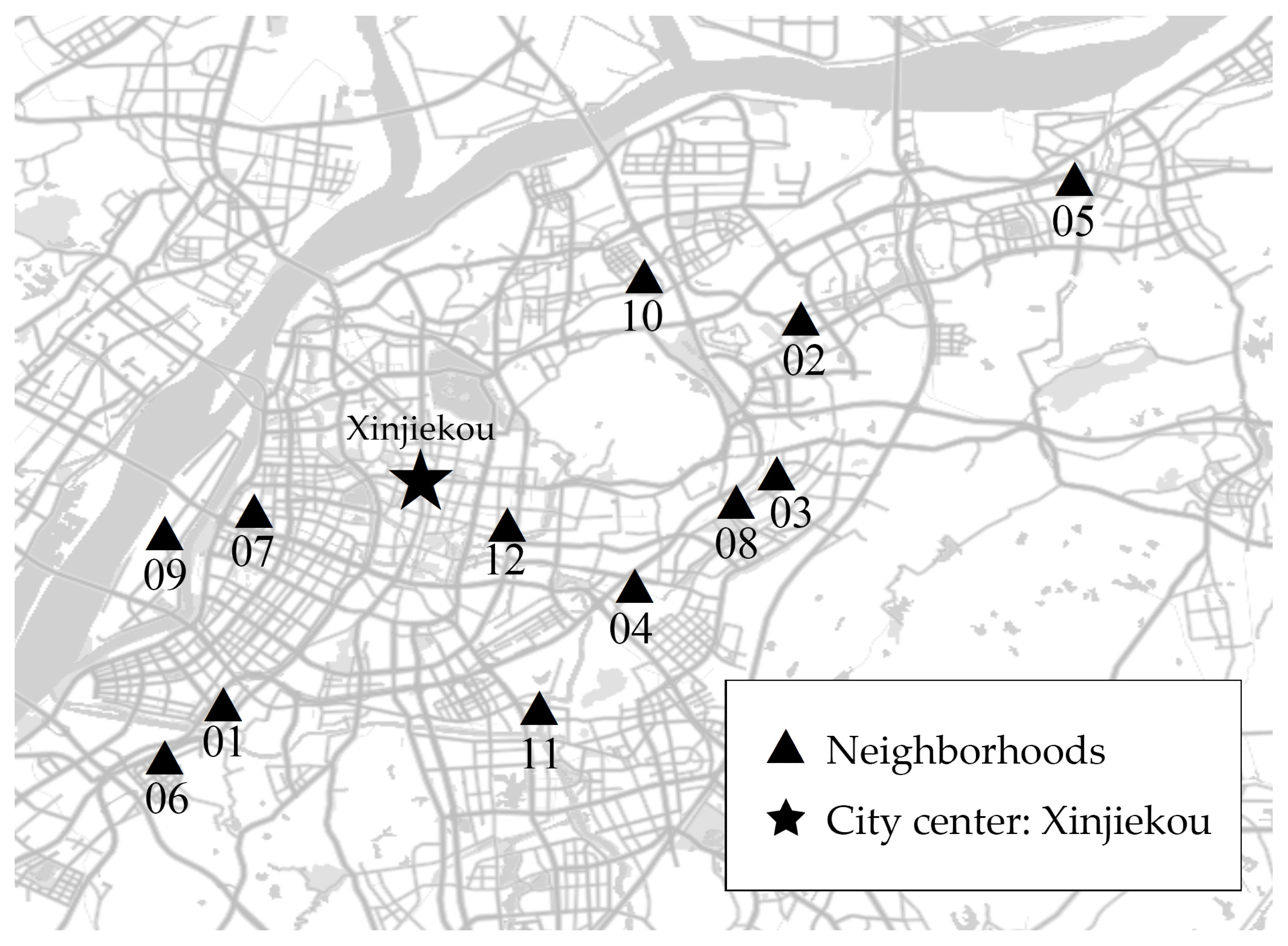
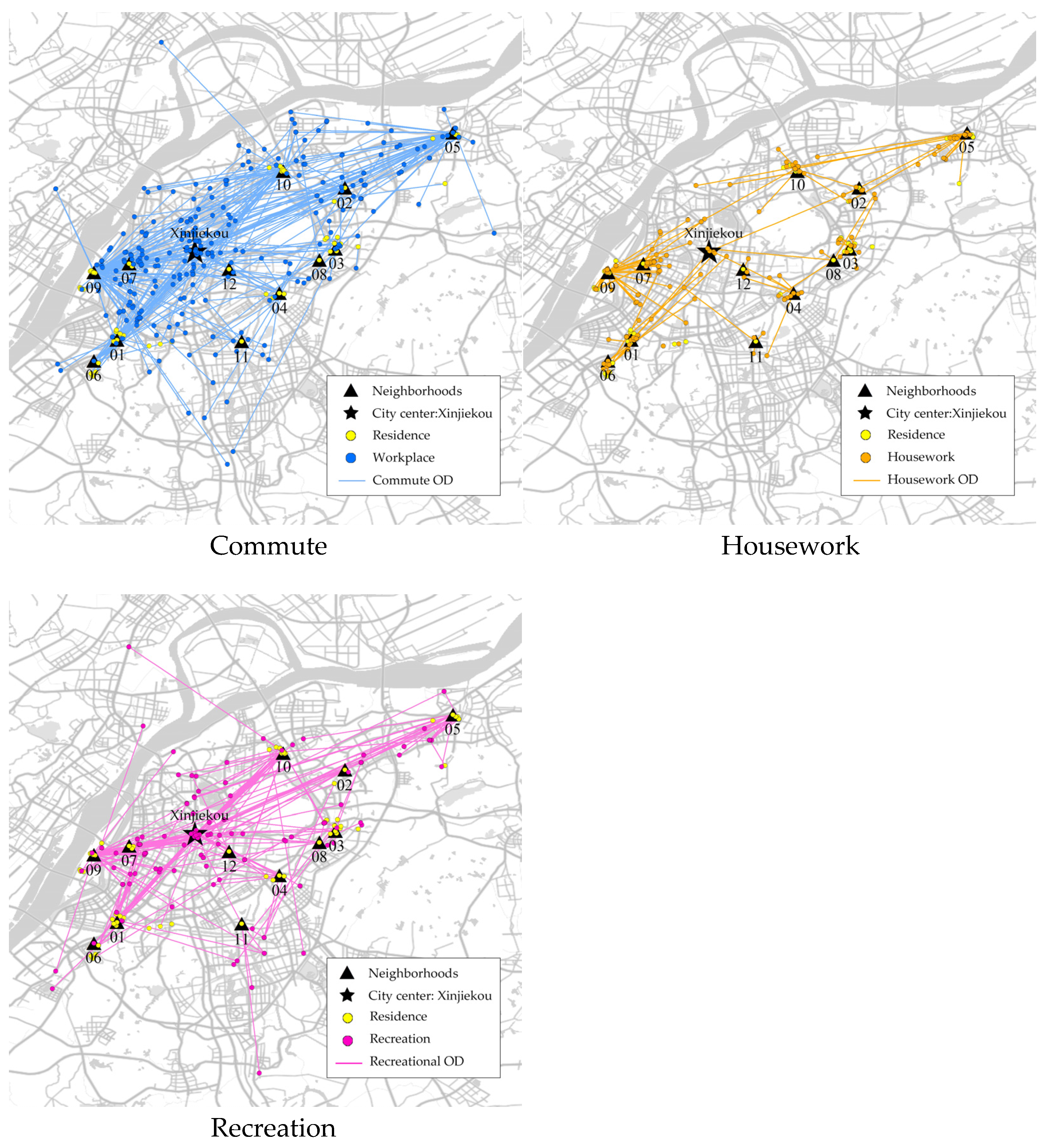
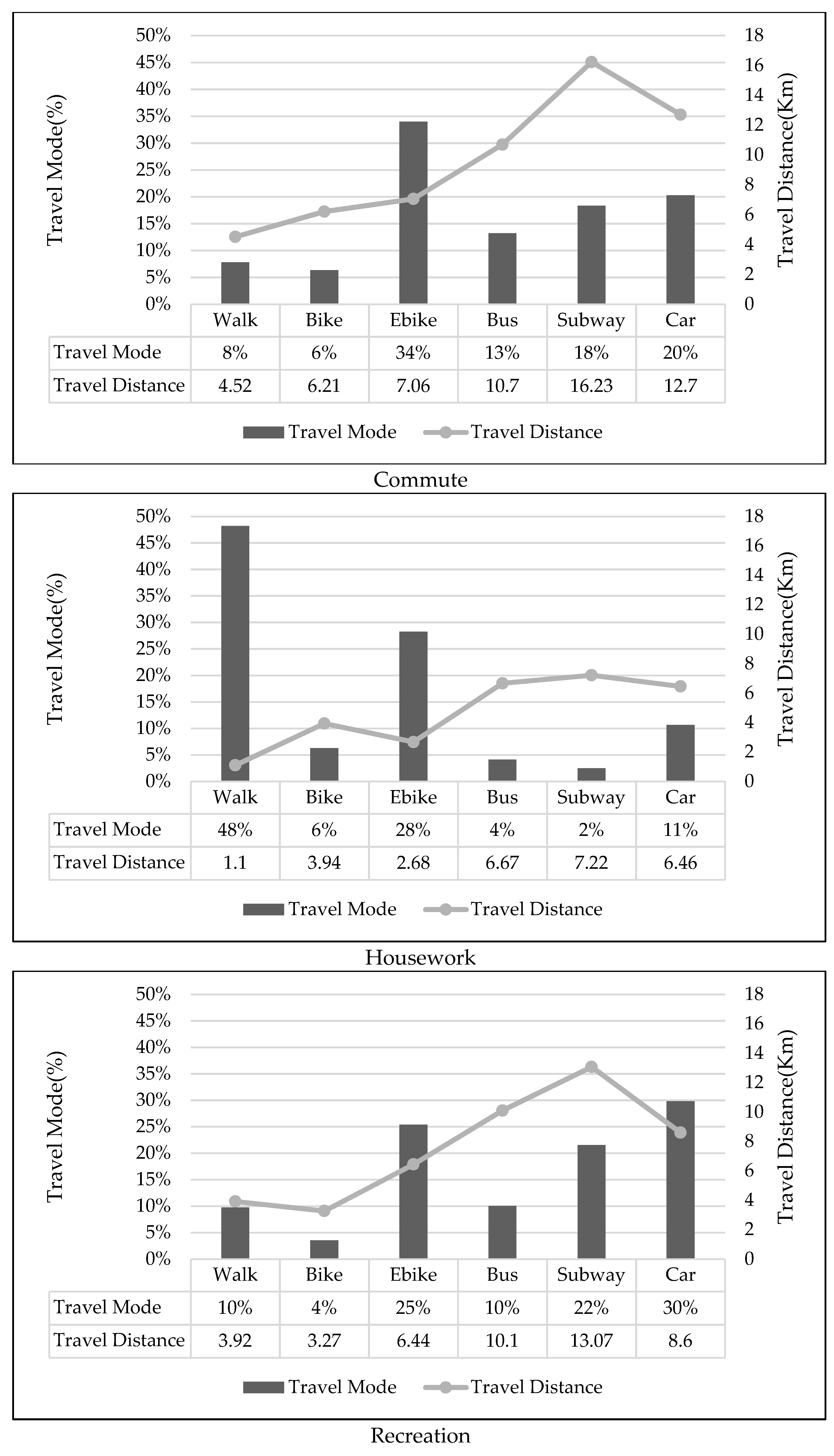
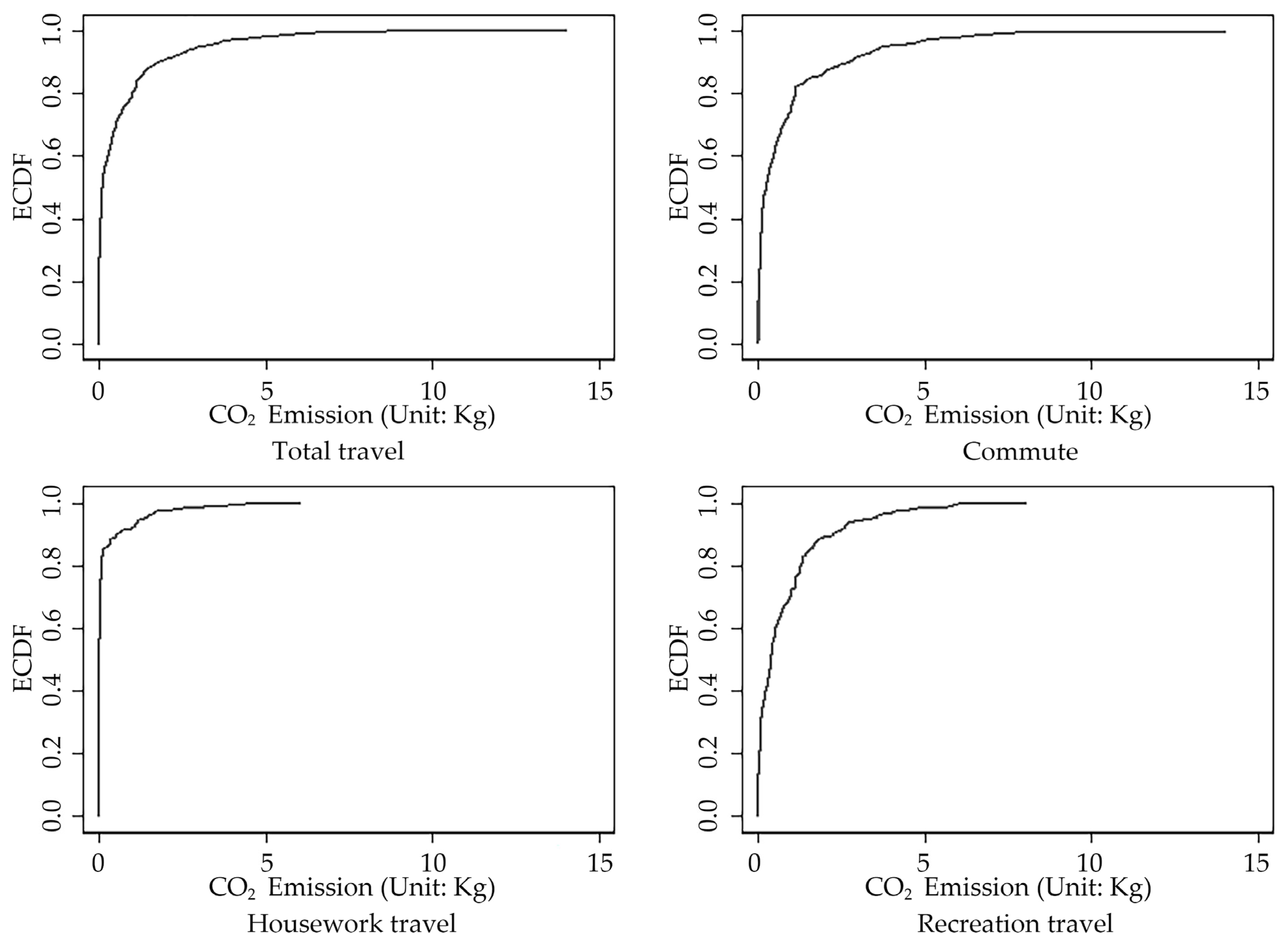
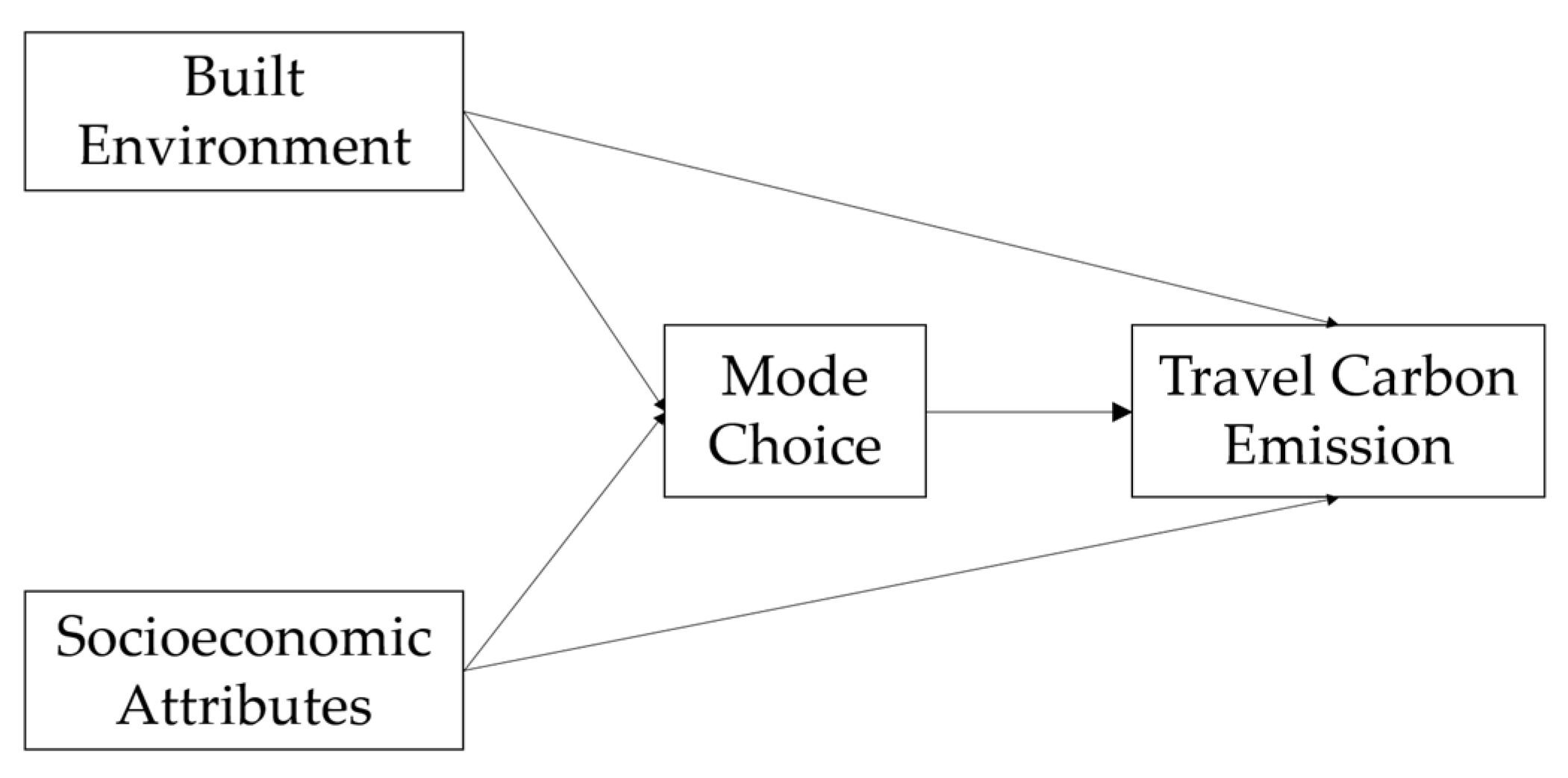
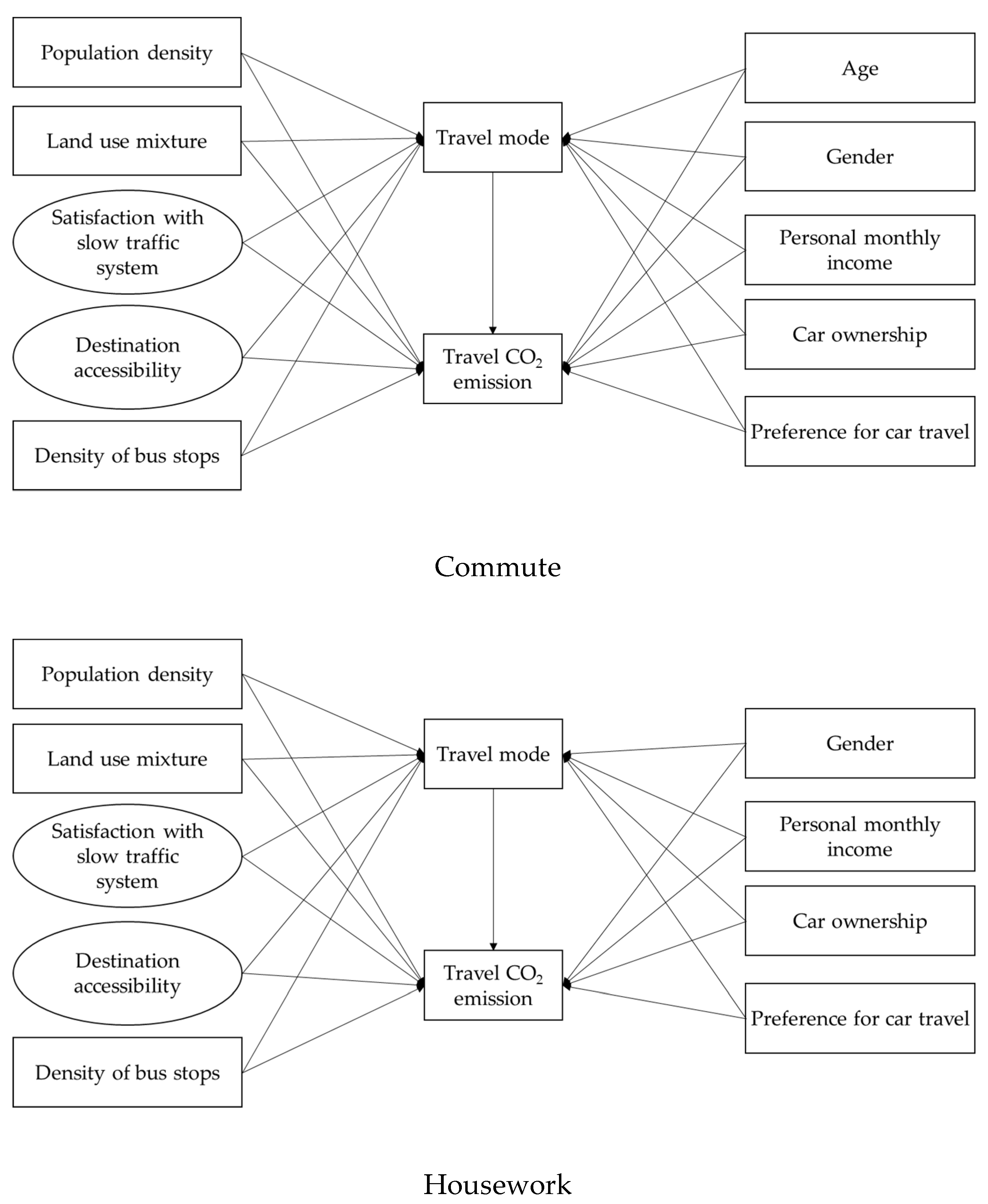
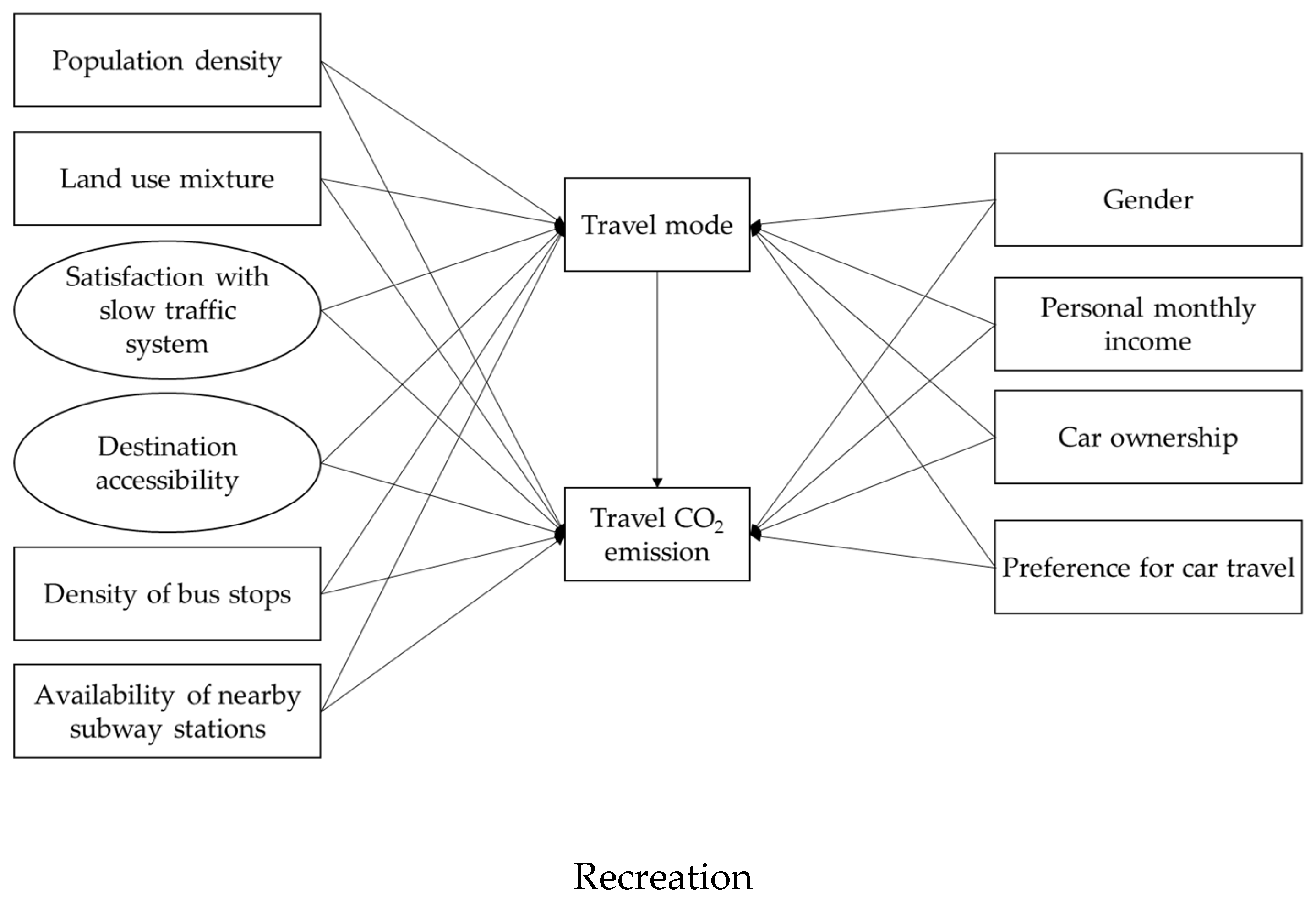
| ID | Name | Year of Construction | Building Form | PD | LUM | DTMS | BSD | Valid Samples |
|---|---|---|---|---|---|---|---|---|
| 01 | Lian Hua Xin Cheng | 2000 (Jia Yuan) 2005 (Bei Yuan) 2012 (Nan Yuan) | HA | 10,010.83 | 0.19 | 627.67 | 6.80 | 32 |
| 02 | Xian Lin Xin Cun | 2001 | MA | 6676.29 | 0.16 | 879.00 | 9.95 | 28 |
| 03 | Bai Shui Qian Cheng, Bai Shui Jia Yuan | Shang Shui Fang (2003) Chun Shui Fang (2003) Bai Shui Jia Yuan (2004) Yun Shui Fang (2007) | MA | 7029.53 | 0.24 | 1754.50 | 3.98 | 26 |
| 04 | Yin Long Hua Yuan | 2004 (Phase I) 2005 (Phase II) | MA | 6355.23 | 0.18 | 4462.00 | 2.99 | 31 |
| 05 | She Shan Xing Cheng | 2005 (Ting Zhu Yuan) 2007 (Shang Ju Yuan) | MA | 3387.50 | 0.22 | 1253.00 | 5.97 | 48 |
| 06 | Dai Shan Qi Xiu Bei Yuan, Dai Shan Qi Xiu Nan Yuan | 2008 (Bei Yuan) 2010 (Nan Yuan) | HA | 3126.14 | 0.18 | 986.00 | 6.22 | 36 |
| 07 | Jia He Yuan | 2009 | HA | 7520.09 | 0.27 | 572.00 | 7.96 | 39 |
| 08 | Sheng He Jia Yuan | 2012 | HA | 2678.14 | 0.18 | 2962.00 | 4.48 | 29 |
| 09 | Zhou Dao Jia Yuan, Zhou Dao He Yuan | 2014 (Zhou Dao Jia Yuan) 2015 (Zhou Dao He Yuan) | HA | 1361.86 | 0.24 | 3539.50 | 2.49 | 42 |
| 10 | Ding Jia Zhuang Hui Jie Xin Cheng | 2016 | HA | 5104.24 | 0.18 | 3215.00 | 4.48 | 52 |
| 11 | Qin Wan Jing Yuan | 2017 | HA | 4245.36 | 0.18 | 945.00 | 3.98 | 27 |
| 12 | Yu Dao Jia Ting | 2020 | HA | 34,165.59 | 0.17 | 542.00 | 6.97 | 28 |
| Variable | Level | Frequency | Percentage |
|---|---|---|---|
| Gender | male | 180 | 43.06% |
| female | 238 | 56.94% | |
| Age | ≤20 | 7 | 1.67% |
| 20–30 | 130 | 31.10% | |
| 30–40 | 131 | 31.34% | |
| 40–50 | 89 | 21.29% | |
| 50–60 | 44 | 10.53% | |
| >60 | 17 | 4.07% | |
| Household size | 1–2 | 94 | 22.49% |
| 3–4 | 257 | 61.48% | |
| ≥5 | 67 | 16.03% | |
| Employed size in household | 1–2 | 309 | 73.92% |
| 3–4 | 103 | 24.64% | |
| ≥5 | 6 | 1.44% | |
| Any child under 18 | Yes | 220 | 52.63% |
| No | 198 | 47.37% | |
| Education | Senior high school and below | 99 | 23.68% |
| Junior college | 119 | 28.47% | |
| Bachelor/Master degree | 200 | 47.85% | |
| Occupation | Government or institutional employees | 54 | 12.92% |
| Corporate management/technical employees | 122 | 29.19% | |
| Corporate logistics employees | 71 | 16.99% | |
| Service industry employees | 35 | 8.37% | |
| Self-employed | 15 | 3.59% | |
| Freelancers | 57 | 13.64% | |
| Students | 14 | 3.35% | |
| Non-working/retired | 50 | 11.96% | |
| Length of residence | Less than 1 year | 52 | 12.44% |
| 1–3 years | 89 | 21.29% | |
| 3–5 years | 74 | 17.70% | |
| 5 years or longer | 203 | 48.56% | |
| Personal monthly income | ≤2500 CNY | 58 | 13.88% |
| 2500–5000 CNY | 138 | 33.01% | |
| 5000–10,000 CNY | 141 | 33.73% | |
| 10,000–15,000 CNY | 52 | 12.44% | |
| 15,000–20,000 CNY | 16 | 3.83% | |
| >20,000 CNY | 13 | 3.11% | |
| Car ownership | 0 car | 118 | 28.23% |
| 1 car | 258 | 61.72% | |
| 2 cars | 37 | 8.85% | |
| >2 cars | 5 | 1.20% | |
| Preference for car travel | Yes | 39 | 9.33% |
| No | 379 | 90.67% | |
| Bike/E-bike ownership | Yes | 332 | 79.43% |
| No | 86 | 20.57% |
| Travel Mode | CO2 Emission Factor (kgCO2/PKM) |
|---|---|
| Walk | 0 |
| Bike | 0 |
| E-bike | 0.012 |
| Bus | 0.067 |
| Subway | 0.039 |
| Car | 0.238 |
| Variable | Level | Commute | Housework | Recreation | |||
|---|---|---|---|---|---|---|---|
| CO2 (Kg) | ANOVA | CO2 (Kg) | ANOVA | CO2 (Kg) | ANOVA | ||
| Gender | male | 1.07 | 6.6 (0.011) | 0.19 | 0.06 (0.808) | 0.84 | 0.25 (0.617) |
| female | 0.68 | 0.21 | 0.78 | ||||
| Age | ≤20 | 0.25 | 1.35 (0.243) | 0.11 | 0.51 (0.768) | 0.45 | 0.63 (0.678) |
| 20–30 | 0.78 | 0.18 | 0.76 | ||||
| 30–40 | 0.93 | 0.26 | 0.91 | ||||
| 40–50 | 1.11 | 0.18 | 0.76 | ||||
| 50–60 | 0.51 | 0.15 | 0.94 | ||||
| >60 | 0.60 | 0.02 | 0.46 | ||||
| Personal monthly income | ≤2500 CNY | 0.46 | 2.20 (0.053) | 0.08 | 0.83 (0.527) | 0.53 | 1.43 (0.214) |
| 2500–5000 CNY | 0.67 | 0.18 | 0.80 | ||||
| 5000–10,000 CNY | 1.02 | 0.28 | 0.79 | ||||
| 10,000–15,000 CNY | 1.04 | 0.21 | 0.98 | ||||
| 15,000–20,000 CNY | 1.38 | 0.07 | 1.39 | ||||
| >20,000 CNY | 1.28 | 0.26 | 0.69 | ||||
| Car ownership | 0 car | 0.40 | 7.39 (0.000) | 0.09 | 1.42 (0.236) | 0.53 | 3.65 (0.013) |
| 1 car | 0.95 | 0.23 | 0.85 | ||||
| 2 cars | 1.38 | 0.29 | 1.18 | ||||
| >2 cars | 2.48 | 0.21 | 1.60 | ||||
| Preference for car travel | Yes | 2.29 | 38.88 (0.000) | 0.59 | 14.56 (0.000) | 1.40 | 10.44 (0.001) |
| No | 0.71 | 0.16 | 0.74 | ||||
| Travel mode | Walk | 0.00 | 93.92 (0.000) | 0.00 | 88.84 (0.000) | 0.00 | 72.02 (0.000) |
| Bike | 0.00 | 0.00 | 0.00 | ||||
| E-bike | 0.08 | 0.03 | 0.08 | ||||
| Bus | 0.72 | 0.45 | 0.68 | ||||
| Subway | 0.63 | 0.28 | 0.51 | ||||
| Car (including taxi) | 3.02 | 1.54 | 2.05 | ||||
| Variable Grouping | Variables | Mean | Std. Dev. | Min | Max |
|---|---|---|---|---|---|
| Travel behavior | |||||
| Travel mode | 3.49 | 1.77 | 1 | 6 | |
| Travel purpose | 1.94 | 0.82 | 1 | 3 | |
| Travel CO2 emission | 0.62 | 1.23 | 0.00 | 13.99 | |
| Built environment | |||||
| Density | Population density (10,000 people/km2) | 0.70 | 1.01 | 0.03 | 10.44 |
| Diversity | Land-use mixture | 0.21 | 0.03 | 0.13 | 0.32 |
| Satisfaction with slow traffic system | Sidewalk flatness | 3.61 | 1.04 | 1 | 5 |
| Sidewalk shading | 3.58 | 1.12 | 1 | 5 | |
| Convenience of shared bikes | 3.46 | 1.29 | 1 | 5 | |
| Safety of bicycle lanes | 3.34 | 1.24 | 1 | 5 | |
| Destination accessibility | Density of daily shopping (counts/km2) | 18.78 | 17.37 | 0.99 | 97.48 |
| Density of regional shopping centers (counts/km2) | 5.47 | 4.55 | 0.00 | 17.41 | |
| Density of education facilities (counts/km2) | 2.72 | 1.57 | 0.00 | 7.96 | |
| Density of sports facilities (counts/km2) | 3.25 | 4.20 | 0.00 | 18.40 | |
| Public transport accessibility | Density of bus stops (counts/km2) | 5.10 | 2.11 | 1.49 | 10.95 |
| Subway stations nearby | 0.51 | 0.50 | 0 | 1 | |
| Model Fit Index | Reference Value | Model 1: Commute Model | Model 2: Housework Model | Model 3: Recreation Model |
|---|---|---|---|---|
| Chi-square (χ2) | - | 228.244 | 153.867 | 180.715 |
| Degrees of freedom (df) | - | 92 | 79 | 89 |
| Goodness-of-Fit Index (GFI) | >0.9 | 0.947 | 0.954 | 0.947 |
| Comparative Fit Index (CFI) | >0.9 | 0.955 | 0.971 | 0.967 |
| Root Mean Square Error of Approximation (RMSEA) | <0.08 | 0.06 | 0.051 | 0.055 |
| Variables | Effect | Model 1: Commute | Model 2: Housework | Model 3: Recreation | |||
|---|---|---|---|---|---|---|---|
| Travel Mode | CO2 | Travel Mode | CO2 | Travel Mode | CO2 | ||
| Population density | TE | - | - | - | - | - | −0.117 * |
| DE | - | - | - | - | - | −0.104 ** | |
| IE | - | - | - | - | - | −0.013 | |
| Land-use mixture | TE | - | - | - | - | - | −0.163 *** |
| DE | - | - | - | - | - | −0.111 ** | |
| IE | - | - | - | - | - | −0.053 | |
| Satisfaction with slow traffic system | TE | - | −0.130 *** | - | - | - | - |
| DE | - | −0.090 ** | - | - | - | - | |
| IE | - | −0.040 | - | - | - | - | |
| Destination accessibility | TE | - | −0.172 *** | −0.157 ** | −0.178 *** | - | - |
| DE | - | −0.118 ** | −0.157 ** | −0.090 | - | - | |
| IE | - | −0.055 | - | −0.088 ** | - | - | |
| Density of bus stops | TE | −0.153 *** | 0.080 * | - | - | −0.325 *** | −0.325 |
| DE | −0.153 *** | 0.169 *** | - | - | −0.325 *** | 0.103 * | |
| IE | - | −0.089 *** | - | - | - | −0.210 *** | |
| Subway stations nearby | TE | - | - | - | - | −0.396 *** | −0.246 *** |
| DE | - | - | - | - | −0.396 *** | 0.010 | |
| IE | - | - | - | - | - | −0.257 *** | |
| Travel mode | TE | - | 0.582 *** | - | 0.560 *** | - | 0.648 *** |
| DE | - | 0.582 *** | - | 0.560 *** | - | 0.648 *** | |
| IE | - | - | - | - | - | - | |
| Age | TE | 0.102 ** | 0.076 ** | - | - | - | - |
| DE | 0.102 ** | 0.016 | - | - | - | - | |
| IE | - | 0.060 ** | - | - | - | - | |
| Personal monthly income | TE | 0.113 ** | 0.079 * | - | - | - | - |
| DE | 0.113 ** | 0.014 | - | - | - | - | |
| IE | - | 0.066 ** | - | - | - | - | |
| Car ownership | TE | 0.160 *** | 0.161 *** | - | - | 0.123 ** | 0.148 ** |
| DE | 0.160 *** | 0.068 ** | - | - | 0.123 ** | 0.068 | |
| IE | - | 0.093 *** | - | - | - | 0.080 ** | |
| Preference for car travel | TE | 0.331 *** | 0.263 *** | 0.154 ** | 0.179 *** | 0.171 *** | 0.139 ** |
| DE | 0.331 *** | 0.070 | 0.154 ** | 0.093 * | 0.171 *** | 0.028 | |
| IE | - | 0.193 *** | - | 0.086 ** | - | 0.111 *** | |
Publisher’s Note: MDPI stays neutral with regard to jurisdictional claims in published maps and institutional affiliations. |
© 2022 by the authors. Licensee MDPI, Basel, Switzerland. This article is an open access article distributed under the terms and conditions of the Creative Commons Attribution (CC BY) license (https://creativecommons.org/licenses/by/4.0/).
Share and Cite
Zhang, Y.; Zhou, W.; Ding, J. Effects of the Built Environment on Travel-Related CO2 Emissions Considering Travel Purpose: A Case Study of Resettlement Neighborhoods in Nanjing. Buildings 2022, 12, 1718. https://doi.org/10.3390/buildings12101718
Zhang Y, Zhou W, Ding J. Effects of the Built Environment on Travel-Related CO2 Emissions Considering Travel Purpose: A Case Study of Resettlement Neighborhoods in Nanjing. Buildings. 2022; 12(10):1718. https://doi.org/10.3390/buildings12101718
Chicago/Turabian StyleZhang, Yiwen, Wenzhu Zhou, and Jiayi Ding. 2022. "Effects of the Built Environment on Travel-Related CO2 Emissions Considering Travel Purpose: A Case Study of Resettlement Neighborhoods in Nanjing" Buildings 12, no. 10: 1718. https://doi.org/10.3390/buildings12101718
APA StyleZhang, Y., Zhou, W., & Ding, J. (2022). Effects of the Built Environment on Travel-Related CO2 Emissions Considering Travel Purpose: A Case Study of Resettlement Neighborhoods in Nanjing. Buildings, 12(10), 1718. https://doi.org/10.3390/buildings12101718







